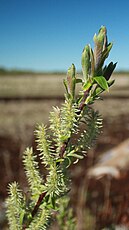| Salix discolor | |
|---|---|

| |
| Shoot with leaves | |
| Scientific classification | |
| Kingdom: | Plantae |
| Clade: | Tracheophytes |
| Clade: | Angiosperms |
| Clade: | Eudicots |
| Clade: | Rosids |
| Order: | Malpighiales |
| Family: | Salicaceae |
| Genus: | Salix |
| Species: | S. discolor
|
| Binomial name | |
| Salix discolor | |

| |
| Natural range of Salix discolor | |
Salix discolor, the American pussy willow[2] or glaucous willow,[3] is a species of willow native to North America, one of two species commonly called pussy willow.
It is native to the vast reaches of Alaska as well as the northern forests and wetlands of Canada (British Columbia east to Newfoundland), and is also found in the northern portions of the contiguous United States (Washington east to Maine, and south to Maryland).[2][4][5]
It is a weak-wooded deciduous shrub or small tree growing to 6 m (20 ft) tall, with brown shoots. The leaves are oval, 3–14 cm long and 1–3.5 cm broad, green above and downy grey-white beneath.
The flowers are soft silky silvery catkins, borne in early spring before the new leaves appear, with the male and female catkins on different plants (dioecious); the male catkins mature yellow at pollen release.
The fruit is a small capsule 7–12 mm long containing numerous minute seeds embedded in cottony down.[4][5]
Cultivation and uses[edit]
Like other willows, it contains salicin, and was used by Native Americans as a painkiller.[5]
As with the closely related Salix caprea (European pussy willow), it is also often grown for cut flowers. Pussy willow has further cultural information and other uses.
Ecology[edit]
Male flowers provide pollen for bees, and it is a popular larval host, supporting the Acadian hairstreak, black-waved flannel moth, cecropia moth, Compton's tortoiseshell, cynthia moth, dreamy duskywing, eastern tiger swallowtail, elm sphinx, imperial moth, Io moth, modest sphinx, mourning cloak, polyphemus moth, promethea moth, red-spotted purple, small-eyed sphinx, twin-spotted sphinx, and viceroy.[6]
-
Branch with catkins in early spring
-
Female flowers
-
Male flowers
References[edit]
- ^ Stritch, L. (2018). "Salix discolor". IUCN Red List of Threatened Species. 2018: e.T126589188A126591045. doi:10.2305/IUCN.UK.2018-2.RLTS.T126589188A126591045.en. Retrieved 11 April 2024.
- ^ a b "Salix discolor". Germplasm Resources Information Network. Agricultural Research Service, United States Department of Agriculture. Retrieved 10 January 2018.
- ^ BSBI List 2007 (xls). Botanical Society of Britain and Ireland. Archived from the original (xls) on 2015-06-26. Retrieved 2014-10-17.
- ^ a b Plants of British Columbia: Salix discolor
- ^ a b c Borealforests: Salix discolor
- ^ The Xerces Society (2016), Gardening for Butterflies: How You Can Attract and Protect Beautiful, Beneficial Insects, Timber Press.



